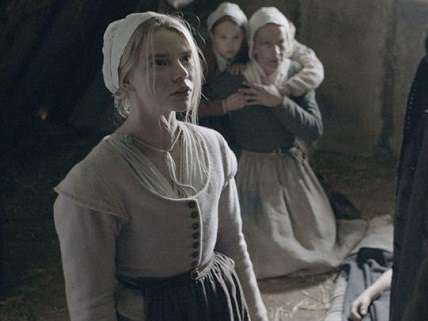Movie Review: The Witch
Meet the Devil.


For a horror movie, The Witch isn't especially horrifying, but it's a masterful exercise in godforsaken atmosphere. Set in Puritan Massachusetts in the year 1630, it presents us with a world in which Satan is real, if only because everyone believes him to be. A farmer named William (Ralph Ineson) has turned his back on his austere religious community—he finds it to be insufficiently grim—and has struck out with his wife Katherine (Kate Dickie) and their five children to found a homestead of their own on the edge of a remote, spooky forest. It's a hard place of pewter-gray days and long nights, filled with strange rustlings and eerie portents (the local wildlife is exceedingly creepy). The children have been well-drilled by their parents in the wages of sin, and after the family's first corn crop fails, and their baby son vanishes in the blink of an eye, we wait for the devil to really bring the hammer down. It's a short wait.
The story unfolds through the eyes of the eldest child, Thomasin (Anya Taylor-Joy), a girl on the cusp of puberty (always a bad place to be in these sorts of stories). Together with her brother Caleb (Harvey Scrimshaw), who's been venturing peeks at her modestly flourishing bosom, she ventures into the woods in search of the missing baby. Brother and sister are soon separated, and in a scene of dark fairy-tale enchantment, we see Caleb encountering a beautiful red-cloaked woman who lures him to her for a very grown-up kiss. When William appears in search of the kids, he finds only Thomasine. Father and daughter return home, and later that night, Caleb does, too, naked and delirious. Thomasine's younger siblings Jonas (Lucas Dawson) and Mercy (Ellie Grainger), prefiguring the child accusers of the Salem witch trials 62 years later, denounce their sister and stoke their parents' growing suspicion as well ("Silence, creature!" William shouts when Thomasine attempts to defend herself.) Things look bad for a while, and then much worse.
The movie is a first feature by writer-director Robert Eggers, who started out as a production and costume designer. His researches among prayer manuals, court documents and personal diaries of 17th Century New England, and his fondness for the uncanny effects obtained by earlier directors like Murnau, Bergman and Kubrick (there are clear echoes of The Shining here), have enabled him to place us convincingly in another age—a time of dirt-floor huts, raw wool and wrinkly linen, and vivid linguistic formulations. ("Wouldst thou like to live deliciously?") Working with cinematographer Jarin Blaschke, he shot the film in bleak daylight and flickering candle-glow, with minimal makeup applied to the actors (mostly natural sweat and grime). He draws strong, steely performances from Ineson and Dickie, as two people imprisoned in a world of severe belief; and he helps launch the strikingly self-possessed Taylor-Joy into what could soon be stardom.
The picture is thick with unsettling sights and sounds: crashings on the roof, a cracked egg with a bloody chick hanging out of it, an ominously ubiquitous black goat. There are a couple of throat-clenching jolts, but the picture's general effect is one of muted beauty and mounting unease. Which, by the time the fantastical ending arrives, turns out to be enough.


Show Comments (32)